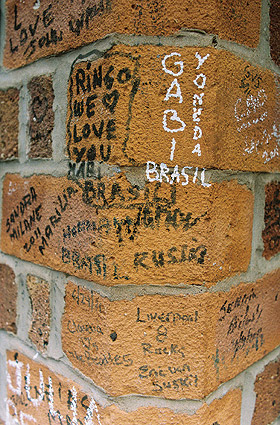
| HOME |
| NERVE |
| REVIEWS |
| ARCHIVE |
| EVENTS |
| LINKS |
| ABOUT US |
| CONTRIBUTORS |
| BACK ISSUES |
| CONTACT US |
Back to index of Nerve 20 - Summer 2012
 My
Liverpool Home
My
Liverpool Home
By Rob Harrison
My first impression of the Dingle was that I had somehow landed on the set of a Morrissey video shoot - kids playing football, mothers chatting in the streets - an England now supposedly passed into history, one of warm beer and jobs for everyone, a working class arcadia.
On the surface to a newcomer like myself, well, from the greater Merseyside area at least, the Dingle looks quite idyllic, yet beyond the surface radical changes have occurred within the area.
Looking at old newsreel footage of the Dingle shows a really completely different place from today. It looks like another country, let alone a place in England. More like America, alive with activity and bustling with confidence.
One of the main features of the Chicago cityscape (I had been a resident there for two years) is the overhead railway with its wood and metal structure that slithers around the giant skyscrapers. Travelling on this ramshackle structure is similar to an old fashioned roller coaster ride in a seaside town - it's an amazing experience in being able to see the city from the confines of its wooden carriages.
A similar overhead railway ran from the Dingle, but it was broken up in 1956, even though there was a public outcry at the demolition. If you check it out on You Tube you'll see a picture of vitality and excitement, a white hot revolution at work. The railway structure itself, like the buildings in the town centre, dwarfs the people around it. Looking at further archive footage, this time at Mill Street and Park Road, you can see the tenement blocks of Caryl Gardens, Brunswick Gardens, Kings Gardens, more giant structures that have been knocked to the ground.
On our first series of visits to the Dingle three years ago, my wife and I noticed a hodgepodge of buildings and empty land. This is the residue of the destruction of the giant tenements similar to the ones still found in London, Glasgow and New York City. Riding the bus into town you can see that one still remains, interestingly it's in the town centre, discreetly hiding behind the other buildings. Most of these tenements were demolished only to be replaced by dodgy blocks of flats, which in turn fell apart. The tenements themselves would have lasted, I'm sure.
We still have some places that refuse to go, like the Welsh Streets with the ever busy taxis taking foreign visitors to Ringo's house. The door at number nine Madryn Steet is now a shrine. Hundreds of scrawled messages adorn the iron door complete with a Ringo cartoon! It reminds me of the Pere Lachaise cemetery where Jim Morrison's body lies - a strange scene greets you there, crying women and awestruck guys, all camped around the tiny headstone of Jim's grave.
The Welsh Streets are now set to become a political football on a grand scale. When I was there doing research for this article, a middle class couple were busy taking pictures. They later accosted the unknowing foreign tourists telling them they were there as guardians to protect the streets; another cause célèbre for them to get their grubby little mitts into, I suppose.
So what does the future hold for the Dingle? Well, interestingly enough, perhaps its future lies in its own past. We've seen the regeneration of the Florence Institute in the past year. It has risen Phoenix like from dereliction and is now refurbished and gleaming. The Florrie is a much needed boost to the local economy and will host a library, a gym, public entertainment and a cafe which is now open.
Also check out these You Tube films: Toxteth - Mill Street and Park Road and Liverpool Overhead Railway - the Dockers Umbrella